
Table of Contents
Advertisement
Quick Links
How to create a sample film using the Elcometer 4340 Automatic Film Applicator
When it comes to developing products such as paints, varnishes, cosmetics, or glues for example; it's
typical to test their properties part of their development. It's important therefore to ensure that
consistent, repeatable and reproducible films can be made in order to undertake fair and accurate
tests. This is where the Elcometer 4340 Motorised / Automatic Film Applicator comes in.
In this video we're going to show you how to create a film using a film applicator with the Elcometer
4340. While there are a wide range of film applicators available, of varying designs, they all work in
pretty much the same the way. Alternatively, if you want to find out how to create a film using a
spiral bar coater with the Elcometer 4340, make sure you check out our separate "how to" video on
that.
And before we get started, for a full introduction to film application and the Elcometer 4340, make
sure you check out our introduction to Film Application video, and our Applicators Explained video,
detailing the full Elcometer Film Applicator range.
To begin, place the supplied bubble level on the table, and adjust the feet of the unit, until the table
is level. Next, switch the Elcometer 4340 on using the switch at the back of the machine, followed by
the green button on the control panel.
Now you can set your carriage speed – in other words, how quickly the film is applied. Simply set the
dial from 1 to 11, to choose your desired speed. This should only be done when the carriage is
stationary, not while the carriage is moving.
With the speed set, you now set the carriage start and stop positions, which defines the length of
your film. This is set using two knobs on the back of the machine. To adjust the start position, press
the carriage start button, and the carriage will move to the end position. With the carriage now out
of the way, you can unscrew the starting position knob, adjust its position, and then retighten.
To adjust the stop position, press the carriage return button which returns the carriage to the start,
and then adjust the end position knob as before.
With the applicator's speed and distance set, now you can mount the substrate to the table.
Regardless of what kind of table you are using make sure the table and underside of the substrate
are both clean.
On a standard table, mount the substrate securely using the spring clamp. This clamp can be
attached at two locations on the table; one for A3 size substrates, and the other for A4 size
substrates.
On our vacuum tables, which are powered by a separate vacuum pump in order to reduce vibrations
in the unit that could affect the quality of your film, it's slightly different.
When using a perforated vacuum table position your substrate as shown, attach the vacuum pump
using the hose to the connection on the left side of the machine, select the substrate size on the
vacuum control (select ON for A3 substrates, and OFF for A4 substrates), then switch on the vacuum
pump. The substrate will then be drawn onto the table and held firmly. Any areas of the vacuum
table not covered by the specimen should be covered using Scotch tape or a similar removable thin
tape, to prevent any of your product getting into the vacuum table, and to ensure the maximum
amount suction provided by the vacuum table is applied to your substrate. If you don't have any
suitable tape available, don't worry, as strips of paper can also be used to cover the holes.
Advertisement
Table of Contents

Summary of Contents for Elcometer 4340
- Page 1 This is where the Elcometer 4340 Motorised / Automatic Film Applicator comes in. In this video we’re going to show you how to create a film using a film applicator with the Elcometer 4340. While there are a wide range of film applicators available, of varying designs, they all work in pretty much the same the way.
- Page 2 Then press the carriage return button, and you have your completed film. Simply repeat this process as many times as required, with the Elcometer 4340 ensuring you get the same film every time, allowing for consistent, comparable testing.















Need help?
Do you have a question about the 4340 and is the answer not in the manual?
Questions and answers